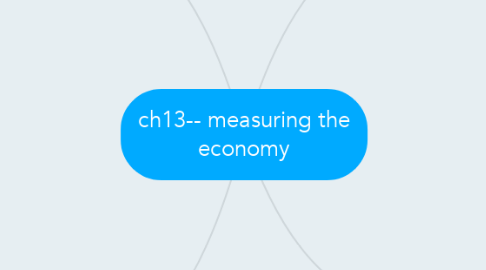ch13-- measuring the economy
by jack thompson

1. 13-2-- How do economist measure the size of an economy?
1.1. they can look at it from two different perspectives. They can study the economic decision making of individuals, households, and firms—the field known as microeconomic
1.2. they can study the workings of the economy as a whole, the focus of macroeconomics.
1.3. Economists typically calculate GDP by measuring expenditures on goods and services produced in a country. They divide the economy into four sectors: households, businesses, government, and foreign trade. Each sector’s spending makes up one of the four components of GDP: household consumption (C), business investment (I), government purchases (G), and the net of exports minus imports (NX). Economists calculate GDP using this formula:
1.4. C + I + G + NX = GDP
1.5. Gross domestic product is the market value of all final goods and services produced within a country during a given period of time.A steadily growing GdP is generally considered a sign of economic health.
2. 13-3--what does the unemployment rate tell us about the economy?
2.1. the unemployment rate is a useful indicator of the health of an economy. In general, a high unemployment rate means the overall health of the economy is poor.
2.2. The job of tracking unemployment belongs to the Bureau of Labor Statistics. The BLS is a government agency that collects and analyzes economic data. This agency determines the unemployment rate—the percentage of the labor force that is seeking work.
2.3. Every month, the BLS reports the total number of people who were unemployed for the previous month. To arrive at this figure, the BLS does not attempt to count every job seeker in the country. Instead, it conducts a sample survey each month. By examining a small but representative sample of the population, the BLS can gauge how many people in the entire population are unemployed.
2.4. lets the bureau know who is unemployed, employed, or in the labor force.
3. 13-4-- what does the inflation rate reveal about the economy?
3.1. A second cup of coffee that costs more than the first. A pile of money that is more valuable as fuel than as currency. These were some of the bizarre realities of hyperinflation in post–World War I Germany.
3.2. The inflation rate is the percentage increase in the average price level of goods and services from one month or year to the next. It is tracked by the same government agency that tracks the unemployment rate, the Bureau of Labor Statistics.
3.3. Between 2000 and 2012, the annual rate of inflation in the United States ranged from a low of -0.4 percent to a high of 3.8 percent. Whether inflation at these relatively low levels is “healthy” for the economy is open to debate. However, we do know that inflation of any amount exacts economic costs.
3.4. inflation rate- is the percentage increase in the average price level of goods and services from one month or year to the next.
3.5. Deflation- the inflation rate is usually a positive number, meaning that the overall price level is rising. but the inflation rate can be negative.
4. 13-5-- how does the business cycle relate to economic health?
4.1. Article: http://www.frbsf.org/education/publications/doctor-econ/2002/may/business-cycles-economy
4.2. the article ties into the question because it gives us a detailed explanation on what is the business cycle and more effects it has on society and the economy
4.3. Business cycle- the rucurring periods of growth and decline in economic activity that all economies experience
4.4. Lagging economic indicates- measures that consistently rise or fall several months after an expansion or contraction
4.5. the business cycle has many parts to it and can grow decline and has turning points unpredictably with these shifts it helps us know and go from one period to the next.
4.6. a boom is the expansion phase of the cycle. it may also be known as recovery, upturn, uprising, upswing or period of prosperity. all of these terms mean the same thing. the economy is healthy and growing


